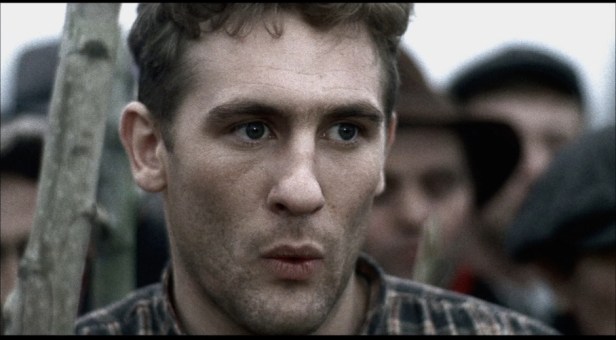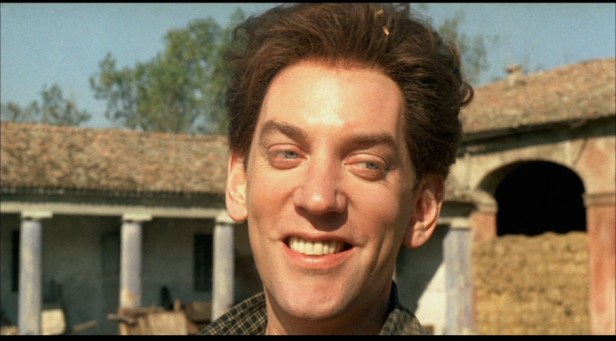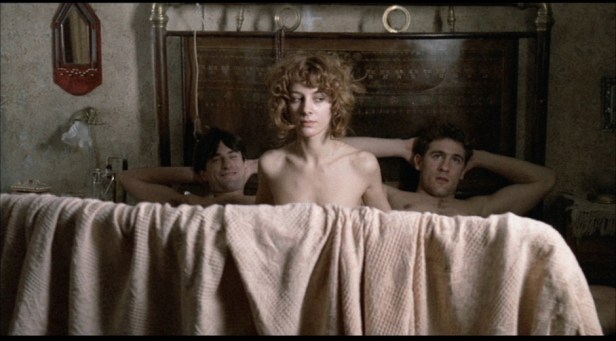Bernardo Bertolucci’s epic historical melodrama of family and political ideas has had a difficult time reaching audiences in the form that the director intended. In April 2016 the excellent Masters of Cinema label released a 2 disc Blu-ray package offering the full version in the correct ratio and with supporting materials. Now seems a good time to try to revise ideas about a major film from the 1970s.
Bertolucci moved into production of Novecento (see below on titles) in 1974/5 at a time when his stock was high, especially after the great international commercial success of Last Tango in Paris in 1972. Because of this potential ‘bankability’, producer Alberto Grimaldi was able raise a budget equivalent to $9 million – a very large budget for an Italian film at this time. However, Grimaldi’s deal with Hollywood distributors demanded a film of 195 minutes and the cut that Bertolucci showed at Cannes in 1975 ran to 317 minutes. Forced to cut, Bertolucci managed to come up with a single film lasting 247 minutes with an English dub. This was eventually released in many territories (it reached the UK at the turn of 1977/78). Meanwhile a two-part film comprising all the material was released in Italy, France and other European territories in Italian/French/German dubbed versions in 1976. All Italian films were routinely post-dubbed at this time. Novecento has an international cast but the subtitled version of the Italian dub on the new discs didn’t present me with any problems. IMDB lists the film as 1:1.66, the ratio common in Europe post the adoption of widescreen in the 1950s. The MoC discs offer a 1:1.85 version. I’m guessing that this was a condition of the film’s international release.


The Hollywood distributors also seem to have chosen the ‘1900’ title. This is misleading. ‘Novecento’ doesn’t translate directly but Bertolucci’s intention was to suggest the ‘new century’ and its history – the ‘1900s’ perhaps. He thought about a second production (“a third act”) which would follow the story after 1945. He discusses this in an interview on the MoC disc of Part One (the same interview that appeared on a Paramount DVD in 2006). The film narrative begins on the day in 1901 when two male births bring grandsons to the landowner (padrone) of a large estate in Emilia-Romagna and to the patriarch of the large extended family of paesani who live and work on the estate. The padrone is played by Burt Lancaster and the paesano Leo Dalcò by Sterling Hayden. Lancaster reportedly worked for no fee because he liked the script (he was working on Visconti’s Conversation Piece (1974) when Bertolucci approached him – he had played a similar role as an aristocratic landowner in Visconti’s The Leopard in 1963). I think Bertolucci and his scriptwriters introduced the traditional patriarchs and then skipped a generation to introduce two characters who in some way represent the ‘modernity’ of the early 20th century.



Olmo (‘Elm’) is the paesano as played by Gerard Depardieu. Alfredo is the future padrone played by Robert De Niro. Olmo’s father is ‘unknown’. Alfredo’s father Giovanni is a new style capitalist and a bad father – forcing Alfredo into the company of his uncle Ottavio (who should have inherited the estate but instead has become an aesthete). It is Giovanni who hires the foreman Attila – who later joins the new Fascist Party in the 1920s and becomes the third major figure in the narrative played by Donald Sutherland. Attila appears along with a threshing machine in 1918 just as Olmo returns from the war and begins to move into working for the new communist party of Italy – marking the beginning of the struggle between landowners and agricultural workers. This aspect of the story reminded me of the (slightly earlier) stories featuring agricultural workers in the novels of Thomas Hardy and their filmic adaptations.
Bertolucci in his interview speaks about himself being a ‘country boy’ from Emilia and that this history is essentially about an agricultural community. Certainly the great events of the period are ‘off-screen’ – we only see what happens on the estate and in the neighbouring town (apart from the trip ‘away’ when Alfredo visits Ottavio and meets his future wife Ada (Dominique Sanda)). I enjoyed the whole film but the two aspects I enjoyed most were the presentation of the landscape and the collective actions of the agricultural workers. The film was photographed by Vittorio Storaro, Bertolucci’s regular collaborator. I was surprised to read a comment in Pierre Sorlin’s Italian National Cinema 1896-1996 in which the author compares Antonioni’s and Bertolucci’s use of the same landscapes in the Po valley. Sorlin suggests Bertolucci’s rural landscapes (he is referring to 1900 and Before the Revolution) offer “a countryside without workers, a land where crops seemed to grow by themselves”. But this seems to me to be totally inaccurate in relation to Novecento. There are several important scenes related directly to groups of agricultural workers busy in the fields, socialising in the woods and working in the farmyard. The entire last sequence of the film depicts the workers occupying the estate and cornering the fascists alongside the resigned Alfredo as padrone. It is the collectivism of these scenes which stands out – whether it is the women with their giant red flag or the men standing up to the fascists.




Watching the film more than 40 years after it was shot, it is still a surprise at how sex is represented on screen. So much was cut from the English dub that little was said about the displays of male genitalia which would have been a problem for a full length release in 1976. (There is, however, an unfortunate dialogue about this on the IMDB bulletin board.) The sex scenes seem to me to be open, ‘natural’ and part of the story, but I was shocked by the brutal violence perpetrated by Attila. The main players in the drama – the five international stars pictured above – are all male and the story is about the birth and subsequent lives of two men, but much of the political discourse in the film is presented through the actions of the female characters, especially Olmo’s partner Anita (Stefania Sandrelli), Laura Betti as Regina on the fascist side, and in smaller roles, but equally important, the women of the Dalcò clan led by Maria Monti as Olmo’s mother. Dominique Sanda as Ada, Alfredo’s wife, is the top-billed female star but hers is an important role in the drama of Alfredo’s life away from politics – though it is Alfredo’s failure to act when Olmo is threatened by Attila that causes a rift between the padrone and his wife. Finally, Stefania Casini as a young woman in the town has two important sequences in the narrative – one in a sex scene. Bertolucci was a controversial figure after Last Tango in Paris – especially after the revelations about his treatment of his young star Maria Schneider. Because of that the role of the women and their representations on screen in Novecento might have attracted more attention and perhaps obscured some of the political discourse. It’s interesting to read contemporary reviews.
In Monthly Film Bulletin (January 1978) Jill Forbes finds herself in the odd position of reviewing the English dub of the cut version of the film but also acknowledging that having seen the Italian version she can recognise that most of what she sees as responsible for the failure of the film is not present in the full version. She recognises that Bertolucci is able to combine different elements – conventions from bourgeois literature alongside folktales, farce, Italian comedy etc. – and to place them in context with the gradual unfolding of historical progress in the countryside. Forbes sees exactly the kind of damage Hollywood did to Bertolucci’s great work. In Sight and Sound (Spring 1978) Italian film specialist Geoffrey Nowell-Smith takes a similar line but spends much longer discussing the dub. He makes interesting points about UK vs US vs Italian audiences and I think it is true that for a UK audience subtitling makes a big difference for films which are dubbed automatically in Italian. Certainly I don’t miss the local language inflections when reading the subtitles. Nowell-Smith is less explicit than Forbes about which version he is critiquing, though he seems to share her analysis. He ends by suggesting that “the film’s eccentricity and its incorporation into the staid format of the historical spectacular, proves to be its redemption”.
My feeling is that the film does work – as a saga of two characters and two families – and as a statement about Italian social, economic and political history in one location during the first half of the 20th century. I enjoyed the performances, the cinematography and the music (by Morricone) and I was impressed by the sense of community and collective struggle. I’m also struck by how beautiful and impressive Gerard Depardieu was as a young man.


I think 1900 is is a masterpiece. A fascinating epic, told with energy and guts. And Laura Betti plays one of my all-time favorite movie villainess. Sutherland is terrific too.
LikeLike
This is one of my favourite films by Bertolucci. In fact I have an Italian Blu-Ray without subtitles because I could not [then] get a proper copy with English subtitles.
I was also fortunate enough to see the whole two part Italian full-length version at Il Cinema Ritrovato. Bernardo Bertolucci came along and later talked about the film.
Roy is quite right about the title and also about the workers and the landscape. in fact the film is strongly influenced visually by the paintings of Giuseppe Pellize da Volpeda. Bertolucci also stated that the second part is influenced in parts by Renoir’s La Regle du jeu,
I think this has one of Morricone’s best scores. However, i think Part I is stronger, especially on the radical movement among the peasants. Both parts do have a strong woman character. What I think lets down Part 2 in particular is the final sequence. I felt it was as if Bertolucci could not think of an appropriate comment on which to end.
But a great film and one that repays repeated viewings.
LikeLike
I understand what you mean about the ending, but I think it works in one way. It highlights the way in which sometimes personal relationships survive and even become more important as our connection to major events becomes less tangible. Perhaps in the end Olmo and Alfredo recognise themselves as two parts of the same character. The political struggle has moved on and left them – a process that started as long ago as 1945.
LikeLike
You have summed up what I find problematic. In the first part we have a definite sense of class solidarity, on both sides. That reflects the historical process in Emilia Romagna where the film is set and which is depicted in Volpeda’s painting, which provides a canvas for the opening credits.
In part 2, at the defeat of fascism, that class solidarity survives. But it is lost in the ending. I would have to check the dialogue, but the actions of the peasants in Part I give expression to communal and class solidarity over the personal.
I think Bertolucci changes his values. The key event seems to be entering pscho-analysis in 1970. And the two films about fascism from that year, The Spider’s Stratagem and The Conformist, seem to give expression to this split. There is something of this in the two parts of Novecento, though it is complex.
LikeLike